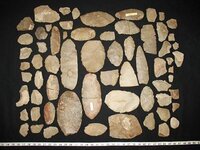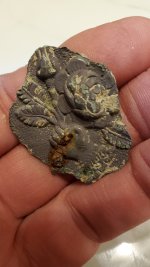GL
Bronze Member
EYOTA, Minn. � In the late 1930s, Adolph Schumann was plowing a corn field on his family’s Olmsted County farm when he hit a rock.
Riding on the moldboard plow behind his team of horses, the teenager was close enough to the soil to see what he had unearthed. It looked like an arrowhead. And there were more.
Adolph came back with his younger brother, Alfred, and they filled a gunny sack.
It was a cache of stone tools left behind 12,000 years earlier by the land’s first inhabitants, one of the most significant archaeological discoveries in the region.
The boys would be old men before anyone knew the significance of their find.
Around 10,000 B.C., at the end of the last ice age, North America’s first settlers made their way from Siberia across the Bering Strait. Within a few hundred years, they had covered most of the continent.
Wooly mammoths, long-horned bison and 400-pound beavers roamed the tundra landscape left behind by retreating glaciers.
Little is known about those people, but archaeologists believe they were nomadic hunter-gatherers, moving in groups of 25 or so, using spear points, knives and other tools flaked from hard “sugar quartz” sand stone found in only a few places in this area. One such outcrop was near Black River Falls.
There, archaeologists discovered, people chipped out rough tool blanks that could later be shaped for specific uses. They carried these stone forms on their hunting forays and buried caches they could return to as they needed to retool.
On a knoll above the creek that would eventually be called the Middle Fork of the Whitewater River, a band of hunters stashed about 20 pounds of stone tools � tools they had carried nearly 100 miles through rugged bluff country, across a raging Mississippi River that was still carving out its valley as it drained vast glacial lakes.
They never returned to claim them.
Over the years, the Schumann boys found more artifacts in their field, and added them to the sack.
Adolph went off to war, Al to college. When they came home, Al worked the home farm, and Adolph bought one down the road.
Neither gave much thought to the pile of rocks until one day in the mid 1960s, when Al read a newspaper story in which an expert said there were no Indian artifacts found in Olmsted County.
“I called him up and said, �Hell, I’ve got a gunny sack full.’”
Schumann brought the sack to the Olmsted County Historical Society, where the artifacts were cataloged and added to the collection.
They sat on a shelf for more than 40 years before anyone noticed.
In 2007, a University of Wisconsin-Milwakuee graduate student named Andy Bloedorn landed a summer internship at the historical society. His job was to inventory the collection.
On his second week, Bloedorn came across a cardboard box. On the side, in magic marker, was written “sugar quartz specimens.”
“I knew that sugar quartz was pretty important material throughout prehistory,” said the 31-year-old Winona resident. “I looked inside, and my jaw kind of dropped.”
There were 65 pieces, all from the same site.
Bloedorn, a graduate of the University of Wisconsin-La Crosse, sent some photos to Robert “Ernie” Boszhardt, the regional archaeologist for the Mississippi Valley Archaeology Center at UW-L.
Boszhardt knew right away what he was seeing.
“These are 12,000 years old,” he said.
To be sure, they had the pieces analyzed by lithic experts.
Dillon Carr, a doctoral candidate at Michigan State University who did his undergraduate work at UW-L, helped confirm the find. He calls it “spectacular.”
The Schumann cache is now part of the Native American collection at the History Center of Olmsted County, where it is on display. It is a time capsule, one of only about 20 from that period found in North America, and likely the oldest in this region.
“I don’t think anybody knew how significant they were,” said museum curator Karl Wolf.
As much as the Schumann cache reveals, it also raises questions.
Some of the pieces were heat-fractured, others tinted by red ochre, suggesting they were left in a ritual.
“What does that mean?” Boszhardt asks. “Why would anybody do that?”
Boszhardt hopes to get a grant so that archaeologists can properly excavate the site.
These days Adolph Schumann is 88. Al is 84, and the farm belongs to his son. But they can still point out the spot where they found the tools.
Both marvel at their connection to prehistoric people.
“A person wonders how this stone � how did that get transferred this far?” Adolph said. “How did they travel, how did they know where they were going?”
More about the stone tools
The Schumann cache of Paleo-Indian stone tools is part of the Native American collection at the History Center of Olmsted County in Rochester, Minn., where they are on display. To learn more about the prehistoric settlers of the Upper Mississippi River Valley, check out “Twelve Millennia” by UW-La Crosse professor James Theler and Robert Boszhardt of the Mississippi Valley Archaeology Center.
LINK
Amazon Forum Fav 👍
Upvote
2





